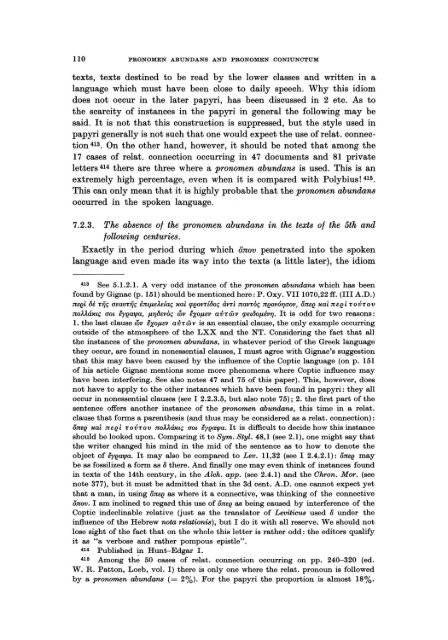Pronomen Abundans and Pronomen Coniunctum. A ... - DWC
Pronomen Abundans and Pronomen Coniunctum. A ... - DWC
Pronomen Abundans and Pronomen Coniunctum. A ... - DWC
Create successful ePaper yourself
Turn your PDF publications into a flip-book with our unique Google optimized e-Paper software.
110 PRONOMEN ABUNDANS AND PRONOMEN CONIUNCTUM<br />
texts, texts destined to be read by the lower classes <strong>and</strong> written in a<br />
language which must have been close to daily speech. Why this idiom<br />
does not occur in the later papyri, has been discussed in 2 etc. As to<br />
the scarcity of instances in the papyri in general the following may be<br />
said. It is not that this construction is suppressed, but the style used in<br />
papyri generally is not such that one would expect the use of relat. connection<br />
413. On the other h<strong>and</strong>, however, it should be noted that among the<br />
17 cases of relat. connection occurring in 47 documents <strong>and</strong> 81 private<br />
letters 414 there are three where a pronomen abundans is used. This is an<br />
extremely high percentage, even when it is compared with Polybius! 415.<br />
This can only mean that it is highly probable that the pronomen abundans<br />
occurred in the spoken language.<br />
7.2.3. The absence ol the pronomen abundans in the texts ol the 5th <strong>and</strong><br />
lollowing centuries.<br />
Exactly in the period during which önov penetrated into the spoken<br />
language <strong>and</strong> even made its way into the texts (a little later), the idiom<br />
413 See 5.1.2.1. A very odd instanee of the pronomen abundans which has been<br />
found by Gignac (p. 151) should be mentioned here: P. Oxy. VII 1070,22 ff. (lIl A.D.)<br />
neei óè TijÇ aeaVTijç èmp.d.elaç xai rpeOVTióoç àvû navroç neOVÓT}aOV, önee xai neei TOVTOV<br />
noÄ.Ädxlç aOI lreatpa, IJTJóevoç wv lxop.ev aVTwv rpetóop.f:vTJ. It is odd for two reasons:<br />
1. the last clause wv lxop.ev aVTwv is an essential clause, the only example occurring<br />
outside of the atmosphere of the LXX <strong>and</strong> the NT. Considering the fact that all<br />
the instanees of the pronomen abundans, in whatever period of the Greek language<br />
they occur, are found in nonessential clauses, I must agree with Gignac's suggestion<br />
that this may have been caused by the influence of the Coptic language (on p . 151<br />
of his article Gignac mentions some more phenomena where Coptic influence may<br />
have been interfering. See also notes 47 <strong>and</strong> 75 of this paper). This, however, does<br />
not have to apply to the other instanees which have been found in papyri: they all<br />
occur in nonessential clauses (see I 2.2.3.5, but also note 75); 2. the first part of the<br />
sentence offers another instanee of the pronomen abundans, this time in arelat.<br />
clause that forms a parenthesis (<strong>and</strong> thus may be considered as arelat. connection) :<br />
önee xai neei TOVTOV noÄ.Ädxlç aOI lreatpa. It is difficult to decide how this instanee<br />
should be looked upon. Comparing it to Sym. Styl. 48,1 (see 2.1), one might say that<br />
the writer changed his mind in the mid of the sentence as to how to denote the<br />
object of lreatpa. It mayalso be compared to Lev. 11,32 (see I 2.4.2.1): önee may<br />
be as fossilized a form as IJ there. And finally one may even think of instanees found<br />
in texts of the 14th century, in the Alch. app. (see 2.4.1) <strong>and</strong> the Ohron. Mor. (see<br />
note 377), but it must be admitted that in the 3d cent. A.D. one cannot expect yet<br />
that a man, in using önee as where it a connective, was thinking of the connective<br />
önov. I am inclined to regard th is use of önee as being caused by interference of the<br />
Coptic indeclinabie relative (just as the translator of Leviticus used IJ under the<br />
influence of the Hebrew nota relation'Ï8), but I do it with all reserve. We should not<br />
lose sight of the fact that on the whole this letter is rather odd: the editors qualify<br />
it as "a verbose <strong>and</strong> rather pompous epistie" .<br />
414 Published in Hunt-Edgar I.<br />
415 Among th~ 50 cases of relat. connection occurring on pp. 240-320 (ed.<br />
W. R . Patton, Loeb, vol. I) there is only one where the relat. pronoun is followed<br />
by a pronomen abundans (= 2%). For the papyri the proportion is almost 18%.
















